PLNs & School Transformation
Personal Learning Networks: Using the Power of Connections to Transform Education
By Will Richardson and Rob Mancabelli
(Solution Tree Press, 2011 Learn more)
I have become increasingly interested in personal learning networks in my role as a teacher educator. As all teachers know, a teacher preparation program can provide building blocks for learning, but all teachers need to continually engage in various learning experiences to improve teaching practices. Therefore, I was really looking forward to reading Personal Learning Networks: Using the Power of Connections to Transform Education. However, I also tend toward the pragmatic, rather than the revolutionary.
The authors, Richardson and Mancabelli, make a passionate argument for the use and development of personal learning networks at the teacher, classroom, and school level to transform rather than reform education. This argument feels somewhat heavy-handed at times, but is well made and makes the book worth reading for those interested in examining the power of connected learning at the individual, class, and/or school level.

In making their argument, they devote the bulk of the book to presenting methods for becoming a networked learner, building a networked classroom, and developing a networked school. At each level, individual, classroom, and school specific exemplars are provided to illustrate how becoming networked can positively impact teachers, students, and schools. In each chapter Richardson and Mancabelli provide a renewed presentation of the benefits of increasing the level of connectivity. At each level – individual, classroom, and school – the authors also provide guidance on how to approach implementing connected learning.
Strategies for Building the PLN
In chapter 3, Becoming a Networked Learner, the authors share the story of Tony Baldasaro and his individual transformation. Richardson and Mancabelli explain the benefit of do-it-yourself professional development and the path to learning in networks. The authors argue that learning in networks requires a passion to learn, sharing, quality rather than quantity, a well-developed sense of self-direction, balance, reflection, and continuation of face-to-face networks. This is followed by an overview of five specific tools: Twitter, diigo, Google Reader, Blogger, and Facebook. For each tool, the authors present an overview of the tool, how to get started, and then how to jump in and start using the tool to develop a personal learning network.
Strategies for Building the PLN – at the Classroom Level
In making the move from being a connected learner to creating a networked classroom, the authors argue that the traditional classroom changes significantly. Specifically, the role of the teacher evolves from us as instructors, to that of co-learners and expert filters. The classroom is no longer isolated, but rather it is a “node” among many others with “thin walled” linkages from the classroom to the world. The authors argue that this change is a paradigm shift that brings benefits by way of transparency, collaboration, and a learning-centered, accessible, communication-based classroom that is supportive of problem or inquiry-based learning and driven by authentic assessment.
This paradigm shift is once again illustrated in a case narrative followed by strategies for creating a networked classroom. For example, strategies for connecting students and experts around the world are provided. The authors identify challenges to this change in teaching practice, among them issues of safety and ethical use, ownership and rights, and objections or concerns from parents. The discussion of challenges include ways to overcome or address each issue or concern.
Strategies for Building the PLN – at the School Level
Finally, the book concludes with a chapter about what it takes to ensure the success of the learning transformation at the school level. Richardson and Mancabelli present three cornerstones of effectively creating a networked school: 1) the compelling case, 2) the change team; and 3) the pilot. For each component, they provide strategies for ensuring success. Additionally, challenges to moving towards the networked school are addressed, and arguments and/or strategies to overcome each hurdle are provided.
Supplemental Resources
References in the text to additional resources are made throughout the book and are listed by chapter, on the publisher’s website. The additional resources provide a useful extension of the book and a good starting point for those new to the various social media tools and the concept of personal learning networks. As is typical with technology, the tools and resources change, making some of the provided resources outdated. However, at the time of this review, the vast majority were still valid.
Conclusions
Personal Learning Networks is both a theoretical and practical book that would be useful for both teachers and administrators. The authors make an impassioned argument, provide good resources for those interested in developing a PLN, and even identify some of the challenges to the transformation of education. While it seems that the primary purpose of the book is to convince readers to transform education through the development of PLNs, much time is spent on providing tools to achieve that goal and to overcome various barriers.
I do believe that the authors missed an important tool in developing a PLN — the Smartphone. The anytime, anywhere accessibility to one’s personal learning network via mobile device cannot be underestimated and its inclusion might have been beneficial. Also, as an educational researcher, I would have liked to have seen more research based evidence to support the more anecdotal information about the power of such tools. Overall, I found the book informative, useful, and beneficial for teachers or administrators wanting to develop a personal learning network to transform education as an individual, for a classroom, or for a school.
Dr. Nicole C. Miller is a faculty member in the Department of Curriculum, Instruction, and Special Education at Mississippi State University. She previously worked as a social studies and educational technology teacher/coordinator at a Los Angeles middle school. Her current research interests include middle level teacher preparation and technology integration, including using technology to support teacher learning. In her quest to develop her own PLN, she has become much more active on Twitter @NclWozniak.

































